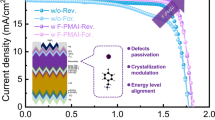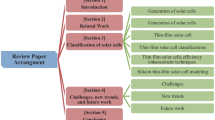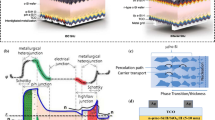Abstract
This work used plasma-enhanced chemical vapor deposition (PECVD) at low temperatures to deposit a silicon nitride layer on multicrystalline silicon (mc-Si), both with and without porous silicon, in an attempt to enhance the multicrystalline silicon’s properties for solar cell applications. Silicon nitride has been successfully tested as a passivation and antireflection film in mc-Si. Consequently, reflectance is reduced from 40 to 7% in the 300–1200 nm wavelength range due to the change in the silicon’s morphology, while the effective carrier lifetime value for the Si substrate rose from 8 µs to 71 µs following SiNx treatment, thus benefitting a solar cell. A laser beam-induced current (LBIC) also revealed an improvement in the diffusion length of minority carriers, with it rising from 150 µm to 432 µm following SiNx treatment. Excellent results were also observed after combining porous silicon with a SiNx thin film, it increased the effective carrier lifetime to 104 µs, the diffusion length to 676 µm, the reflectance reduced to 3%, and the surface recombination velocity reduced to 1.6 cm/s. The obtained results therefore suggest that PECVD-based silicon-nitride-covered porous silicon shows promise in terms of cost-effectiveness and efficiency, thus helping to advance solar cell technology.
Similar content being viewed by others
Data Availability
No datasets were generated or analysed during the current study.
References
Rauf A, Nureen N, Irfan M, Ali M (2023) The current developments and future prospects of solar photovoltaic industry in an emerging economy of India. Environ Sci Pollut Res 30:46270–46281
Bórawski P, Holden L, Bełdycka-Bórawska A (2023) Perspectives of photovoltaic energy market development in the european union. Energy 270:126804
Kurinec SK (2022) Silicon solar photovoltaics: slow ascent to exponential growth. In: Women in mechanical engineering: energy and the environment. Springer International Publishing, Cham, pp 221-243
Dobrzanski LA, Drygała A, Macek M, Giedroc M (2012) Monocrystalline silicon solar cells applied in photovoltaic system. J Achiev Mater Manuf Eng 1:7–13
Tsujino K, Matsumura M, Nishimoto Y (2006) Texturization of multicrystalline silicon wafers for solar cells by chemical treatment using metallic catalyst. Sol Energy Mater Sol Cells 90:100–110
Macdonald DH, Cuevas A, Kerr MJ, Samundsett C, Ruby D, Winderbaum S, Leo A (2004) Texturing industrial multicrystalline silicon solar cells. Sol Energy 76:277–283
González-Díaz B, Guerrero-Lemus R, Díaz-Herrera B, Marrero N, Méndez-Ramos J, Borchert D (2009) Optimization of roughness reflectance and photoluminescence for acid textured mc-Si solar cells etched at different HF/HNO3 concentrations. Mater Sci Eng B 159:295–298
Alshammari AS, Abdulkadir A, Alshammari AS (2023) Properties of phosphoric acid doped crystalline silicon with different light-trapping schemes for solar cells. Mater Sci Semicond Process 154:107219
Qian J, Steegen S, Vander Poorten E, Reynaerts D, Van Brussel H (2002) EDM texturing of multicrystalline silicon wafer and EFG ribbon for solar cell application. Int J Mach Tools Manuf 42:1657–1664
Gangopadhyay U, Dhungel SK, Basu PK, Dutta SK, Saha H, Yi J (2007) Comparative study of different approaches of multicrystalline silicon texturing for solar cell fabrication. Sol Energy Mater Sol Cells 91:285–289
Stalmans L, Poortmans J, Bender H, Caymax M, Said K, Vazsonyi E, Mertens R (1998) Porous silicon in crystalline silicon solar cells: a review and the effect on the internal quantum efficiency. Prog Photovoltaics Res Appl 6:233–246
Strehlke S, Bastide S, Guillet J, Levy-Clement C (2000) Design of porous silicon antireflection coatings for silicon solar cells. Mater Sci Eng B 69:81–86
Mäckel H, Lüdemann R (2002) Detailed study of the composition of hydrogenated SiN x layers for high-quality silicon surface passivation. J Appl Phys 92:2602–2609
Wan Y, McIntosh KR, Thomson AF (2013) Characterisation and optimisation of PECVD SiNx as an antireflection coating and passivation layer for silicon solar cells. AIP Adva 3(3):032113
Nallapati G (1999) Plasma enhanced chemical vapor deposition of silicon nitride and oxynitride films using disilane as silicon source. Louisiana State University and Agricultural & Mechanical College
Smit DL, Andrew SA, Frederick JP (1990) Mechanism of SiN x H y deposition from N2–SiH4 plasma. J Vac Sci Technol B Microelectron Process Phenomena 8:551–557
Smith DL (1993) Controlling the plasma chemistry of silicon nitride and oxide deposition from silane. J Vac Sci Technol A Vac Surf Films 11:1843–1850
Aberle AG (2001) Overview on SiN surface passivation of crystalline silicon solar cells. Sol Energy Mater Sol Cells 65:239–248
Stefaan DW, Guido A, Guy B, Petko V (2005) Influence of stoichiometry of direct plasma-enhanced chemical vapor deposited SiN [sub x] films and silicon substrate surface roughness on surface passivation. J Appl Phys 97:63303
Duerinckx F, Szlufcik J (2002) Defect passivation of industrial multicrystalline solar cells based on PECVD silicon nitride. Sol Energy Mater Sol Cells 72:231–246
Sopori B, Zhang Y, Reedy R, Jones K, Yan Y, Al-Jassim M, Bathley B, Kalegs J (2005) A Comprehensive model of hydrogen transport into a solar cell during silicon nitride processing for fire-through metallization. In: The 31st IEEE Photovoltaics Specialists Conference and Exhibition Lake Buena Vista, Florida January 3–7, 2005, p 4, Florida
Dekkers, HFW, Carnel L, Beaucarne G (2006) Carrier trap passivation in multicrystalline Si solar cells by hydrogen from SiNx: H layers. Appl Phys Lett 89:013508
Lelièvre JF, Fourmond E, Kaminski A, Palais O, Ballutaud D, Lemiti M (2009) Study of the composition of hydrogenated silicon nitride SiNx: H for efficient surface and bulk passivation of silicon. Sol Energy Mater Sol Cells 93:1281–1289
Almeshaal MA, Abdouli B, Choubani K, Khezami L, Rabha MB (2023) Study of porous silicon layer effect in optoelectronics properties of multi-crystalline silicon for photovoltaic applications. Silicon 15:6025–6032
Sharma V, Dhasmana H, Verma A, Kumar A, Kannan CV, Pal Y, Jain VK (2023) A study on passivation improvement in n-passivated emitter rear totally diffused solar cell using rapid thermal annealing. Energy Environ 34:1770–1786
Davidson SM, Dimitriadis CA (1980) Advances in the electrical assessment of semiconductors using the scanning electron microscope. Microscopy J 118:275
Sayad et al (2009) Determination of diffusion length in photovoltaic crystalline silicon by modelisation of light beam induced current. Superlattices Microstruct 45:393–401
Kalem Ş, Göbelek D, Kurtar R, Misirli Z, Aydinli A, Ellialtioḡlu R (1995) The effects of surface treatment on optical and vibrational properties of stain-etched silicon. Nanostruct Mater 6:847
Cullis AG, Canham LT, Calcott PDJ (1997) The structural and luminescence properties of porous silicon. J Appl Phys 82:909
Petres R et al (2005) Passivation of p+-Surfaces by PECVD Silicon carbide films - a promising method for industrial silicon solar cell applications. In: Proceedings of the 15th international photovoltaic science and engineering conference PVSEC-15 / Shanghai, p 128
Libal J et al (2005) N-Type Multicrystalline silicon solar cells: BBr~3-diffusion and passivation of P^+-diffused silicon surfaces. In: 20th European Photovoltaic Solar Energy Conference : proceedings of the international conference held in Barcelona, Spain, 6–10 June
Jemai AB, Mannai A, Khezami L, Mokraoui S, Algethami FK, Al-Ghyamah A, Rabha MB (2020) Aluminum nanoparticles passivation of multi-crystalline silicon nanostructure for solar cells applications. Silicon 12:2755–2760
Achref M, Khezami L, Mokraoui S, Rabha MB (2020) Effective surface passivation on multi-crystalline silicon using aluminum/porous silicon nanostructures. Surf Interfaces 18:100391
Acknowledgements
This work was supported and funded by the Deanship of Scientific Research at Imam Mohammad Ibn Saud Islamic University (IMSIU) (grant number IMSIU-RG23144).
Funding
This research received no external funding.
Author information
Authors and Affiliations
Contributions
The author has read and agreed to the published version of the manuscript.
Corresponding author
Ethics declarations
Competing Interests
The authors declare no competing interests.
Institutional Review Board Statement
Not applicable.
Informed Consent
Not applicable.
Ethics Approval
Not applicable.
Consent for Publication
Not applicable.
Additional information
Publisher's Note
Springer Nature remains neutral with regard to jurisdictional claims in published maps and institutional affiliations.
Rights and permissions
Springer Nature or its licensor (e.g. a society or other partner) holds exclusive rights to this article under a publishing agreement with the author(s) or other rightsholder(s); author self-archiving of the accepted manuscript version of this article is solely governed by the terms of such publishing agreement and applicable law.
About this article
Cite this article
Alrasheedi, N.H. The Effects of Porous Silicon and Silicon Nitride Treatments on the Electronic Qualities of Multicrystalline Silicon for Solar Cell Applications. Silicon 16, 1765–1773 (2024). https://doi.org/10.1007/s12633-023-02803-x
Received:
Accepted:
Published:
Issue Date:
DOI: https://doi.org/10.1007/s12633-023-02803-x




